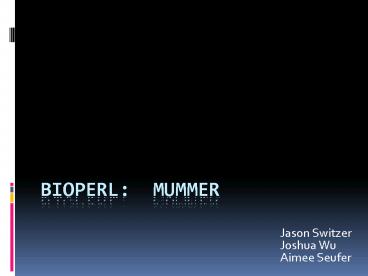BioPerl: MUMmer - PowerPoint PPT Presentation
1 / 26
Title:
BioPerl: MUMmer
Description:
Goal: collect computational methods routinely used in bioinformatics ... bioinformatics toolkit for format conversion, report processing, data ... – PowerPoint PPT presentation
Number of Views:156
Avg rating:3.0/5.0
Title: BioPerl: MUMmer
1
BioPerl MUMmer
- Jason Switzer
- Joshua Wu
- Aimee Seufer
2
Agenda
- Background
- BioPerl
- Mummer
- Algorithm/Data Structure
- Suffix Trees (implicit vs explicit)
- Examples
- Limitations for BioPerl
- BioAlignIOmummer
3
What is BioPerl
- A project (developed by volunteer engineers)
- Goal collect computational methods routinely
used in bioinformatics - Tools for computational molecular biology
- bioinformatics toolkit for format conversion,
report processing, data manipulation, sequence
analysis, batch processing and more - Open source
- http//bioperl.org/
- Collection of modules (1450)
4
Example
5
Example
6
What is MUMmer
- MUMmer maximum unique exact match
- Definition it is a suffix tree algorithm
designed to find maximal exact matches of some
minimum length between two input sequences.
7
Achievements
- Suffix tree a very efficient data structure
- constructed and searched in linear time
- ideal for large scale pattern matching
- Memory usage dependent only on reference sequence
- Finds maximal unique solution to dataset
- How efficient? find all 20 base pair maximal
exact matches between 2 5 million base pair
bacterial genomes in 20 seconds, using 90 MB of
RAM, on a typical 1.7 GHz Linux desktop computer
8
Why Suffix Trees?
- "Suffix trees are widely used in the computer
field... Recent improvements in the method have
cut the memory requirement to 17 bytes per
letter, which brings the method to the verge of
practicality for bioinformatics applications"
-- Nat Goodman (Genome Technology).
9
Introduction
- Any string of length m can be degenerated into m
suffixes, and these suffixes can be stored in a
suffix tree. - Setup time O(m) (m is length of string)
- searching time O(n) (n is length of pattern)
10
(No Transcript)
11
(No Transcript)
12
Sample input Homo Sapien
- cagctcctgagactgctggcatgaaggggagccgtgccctcctgctggtg
gccctcaccctgttctgcatctgccggatggccacaggggaggacaacga
tgagtttttcatggacttcctgcaaacactactggtggggaccccagagg
agctctatgaggggaccttgggcaagtacaatgtcaacgaagatgccaag
gcagcaatgactgaactcaagtcctgcagagatggcctgcagccaatgca
caaggcggagctggtcaagctgctggtgcaagtgctgggcagtcaggacg
gtgcctaagtggacctcagacatggctcagccataggacctgccacacaa
gcagccgtggacacaacgcccactaccacctcccacatggaaatgtatcc
tcaaaccgtttaatcaataa
13
Sample result
14
Sample input 2 plants
- EARPIVVGPPPPLSGGLPGTENSDQARDGTLPYTKDRFYLQPLPPTEAAQ
RAKVSASEILNVKQFIDRKAWPSLQNDLRLRASYLRYDLKTVISAKPKDE
KKSLQELTSKLFSSIDNLDHAAKIKSPTEAEKYYGQTVSNINEVLAKLG
15
Sample output
16
Comparisons Homo Sapiens
17
Chicken
18
Sample Input Chicken
- RVKRVWPLVIRTVIAGYNLYRAIKKK
19
Chicken
20
Investigation
- Explicit suffix trees require more space than
implicit suffix trees in real data. - Explicit trees should be used for smaller use of
storage
21
Limitations on development
- No unified output format for all tools
- Tools available mummer, repeat-match,
exact-tandems, gaps, mgaps, nucmer, promer,
run-mummer1, run-mummer3, show-aligns,
show-coords, show-snps, show-tiling - Variable command line options
- Poor documentation
- Not user-friendly
22
Difficulties With BioPerl
- Extensive Framework
- everything from IO utilities to BLAST
- Aging Codebase
- lots of copy-and-paste
- old coding techniques data
- Few Developers
- few core developers maintaining the toolkit
- few people understand the
- Uncommon Perl Practices
- much derision over practices such as Tie handles
and AUTOLOAD
23
Common BioPerl Objects
- BioSeqIO
- reads/writes sequence files (e.g. genbank)
- fully symmetric converter (between various
formats) - lots of documentation
- BioSeq
- store various sequences (BioRichSeq)
- used primarily with BioSeqIO
- BioAlignIO
- reads/writes alignment files (fasta)
- not fully symmetric (between formats)
- significantly less documentation
- BioLocatableSeq
- stores locatable sequence data (within another
sequence) - used primarily with BioAlignIO
24
Example - Input Data
25
Example - Code
26
THANK YOU FOR LISTENING































